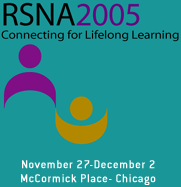
Abstract Archives of the RSNA, 2005
SST07-04
Differentiation Recurrent Tumor from Benign Wall Thickening in Postoperative Stomach Using Helical CT: Results of Univariate and Multivariate Statistical Analysis
Scientific Papers
Presented on December 2, 2005
Presented as part of SST07: Gastrointestinal (Stomach: Gastric Cancer—CT)
Ji Yang Kim , Presenter: Nothing to Disclose
Ji Yang Kim , Abstract Co-Author: Nothing to Disclose
Se Hyung Kim, Abstract Co-Author: Nothing to Disclose
Jeong Min Lee, Abstract Co-Author: Nothing to Disclose
Jae Young Lee, Abstract Co-Author: Nothing to Disclose
Joon Koo Han MD, Abstract Co-Author: Nothing to Disclose
Min Woo Lee MD, Abstract Co-Author: Nothing to Disclose
Jin-Young Choi, Abstract Co-Author: Nothing to Disclose
Soo Jin Kim MD, Abstract Co-Author: Nothing to Disclose
Seung Hong Choi, Abstract Co-Author: Nothing to Disclose
Byung Ihn Choi, Abstract Co-Author: Nothing to Disclose
et al, Abstract Co-Author: Nothing to Disclose
To determine the significant CT features for differentiating recurrent tumor from benign postoperative change in postgastrectomy patients having perianastomotic wall thickening.
In last five years, 69 patients (45 men and 24 women; mean age, 59 years) with perianastomotic wall thickening following gastrectomy were identified from our radiologic and surgical database. All 25 recurred patients had pathologic proof after radical surgery. Forty-four benign patients were diagnosed by the strict clinical criteria. Two radiologists analyzed CT features by consensus for enhancement of thickened wall, homogeneity, symmetricity, proximity to metallic suture material, perigastric infiltration, obliteration of wall layering, lymphadenopathy, adjacent bowel wall thickening, and periceliac soft tissue density. Wall thickeness and its attenuation were recorded by measuring the mean HU of lesion and normal mucosa by averaging three ROI measurements, respectively. Individual CT findings relavant as predictors were identified with Chi-square or Fisher’s exact test. Multivariate, stepwise logistic regression analysis was used to determine the most predictable factors.
Recurrent tumors were thicker (23.0±9.8 mm) than benign thickening (16.6±4.6 mm). Contrast enhancement equal or greater than normal mucosa was more frequently seen in the recurrent tumor (18/25) than in the benign thickening (6/44). Univariate analysis also revealed that perigastric infiltration, obliteration of wall layering, heterogeneity, and lymphadenopathy were significant factors for recurrent tumor while the proximity to metallic suture material was significant for the benign change. Multivariate regression analysis showed that proximity to metallic suture material, presence of perigastric infiltration, iso or high attenuation of thickened wall were only three variables that independently differentiated between recurred tumor and benign thickening.
The perianastomotic wall thickening with contrast enhancement equal to greater than normal mucosa, presence of perigastric infiltration, and metallic suture material away from wall thickening strongly suggest recurrent tumor in postoperative stomach.
Kim , J,
Kim , J,
Kim, S,
Lee, J,
Lee, J,
Han, J,
Lee, M,
Choi, J,
Kim, S,
Choi, S,
Choi, B,
et al, ,
Differentiation Recurrent Tumor from Benign Wall Thickening in Postoperative Stomach Using Helical CT: Results of Univariate and Multivariate Statistical Analysis. Radiological Society of North America 2005 Scientific Assembly and Annual Meeting, November 27 - December 2, 2005 ,Chicago IL.
http://archive.rsna.org/2005/4419807.html

